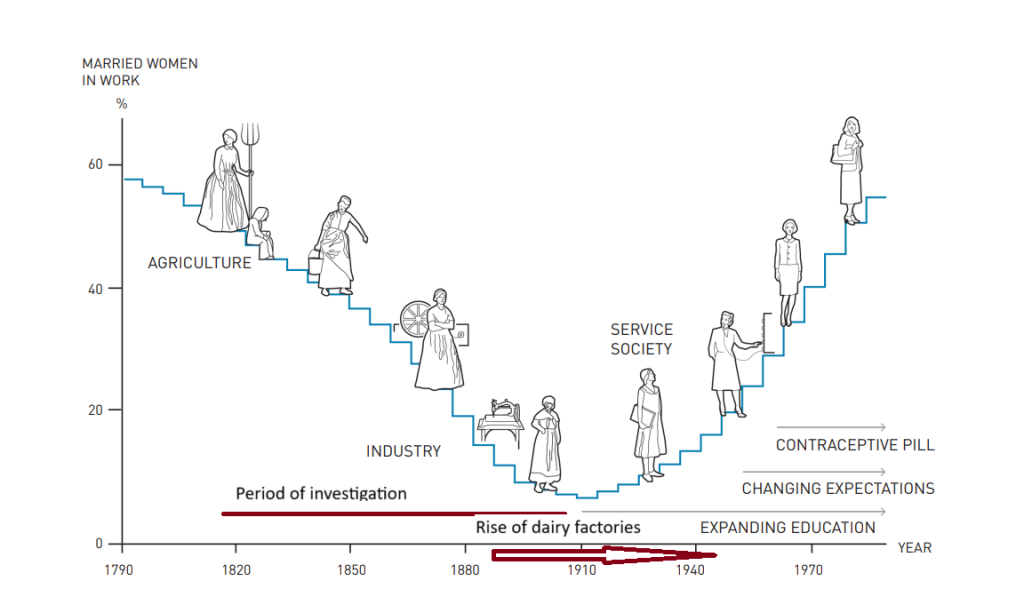Claudia Goldin won the Sveriges Riksbank Prize in Economic Sciences in Memory of Alfred Nobel. I can write about her work. But here, I will be inspired by her work. One of the events she emphasizes is that women’s participation in the ‘GDP’ labor market became less after say 1860, as shown in the figure. Below I will investigate if this model (this is a model) can be used for the interpretation and analysis of my data on long-term agricultural development (yes, it can). The decline of women’s work in agriculture is well-known for farm production of butter and cheese. In many areas, women (the farmers’ wife [no, Grammarly, not ‘wifes’], servants, sometimes daughters) produced butter and, in areas specialized in dairy production on larger farms, butter and low-fat cheese or
Topics:
Merijn T. Knibbe considers the following as important: Uncategorized
This could be interesting, too:
tom writes The Ukraine war and Europe’s deepening march of folly
Stavros Mavroudeas writes CfP of Marxist Macroeconomic Modelling workgroup – 18th WAPE Forum, Istanbul August 6-8, 2025
Lars Pålsson Syll writes The pretence-of-knowledge syndrome
Dean Baker writes Crypto and Donald Trump’s strategic baseball card reserve
Claudia Goldin won the Sveriges Riksbank Prize in Economic Sciences in Memory of Alfred Nobel. I can write about her work. But here, I will be inspired by her work. One of the events she emphasizes is that women’s participation in the ‘GDP’ labor market became less after say 1860, as shown in the figure. Below I will investigate if this model (this is a model) can be used for the interpretation and analysis of my data on long-term agricultural development (yes, it can).

The decline of women’s work in agriculture is well-known for farm production of butter and cheese. In many areas, women (the farmers’ wife [no, Grammarly, not ‘wifes’], servants, sometimes daughters) produced butter and, in areas specialized in dairy production on larger farms, butter and low-fat cheese or full-fat cheese. After 1888, factories wiped out farm production of butter and low-fat cheese, farm production of full-fat cheese lingered for longer. But hours spent by females on dairy production plummeted. Here, is some data about this. Here, an article shows that, on small farms, this led women to concentrate on the production of poultry and eggs while on larger farms, they concentrated on the household. Here, in English, an article about the rise of the factories in the dairy area of Friesland, here, in Dutch, an in-depth book about the actors. This is, however, not only about labor. The latest NBER paper of Claudia Goldin starts as follows (emphasis added):
“In terms of their rights, women have won. By the end of the nineteenth century, American women had won the right to own property, keep their earnings, write legal contracts, manage their own businesses, and be educated. They added much more in the twentieth century including the right to vote in federal elections, be the equal of men in the workplace and in schools, choose their surnames, sit on juries, obtain credit, and exert control over their bodies (despite recent setbacks)“.
We can, using the Goldin framework, not just ask the question if women’s share of market production in this area declined, but also ask the question if women in a dairy area, operationalized as the Frisian dairy area between 1817 and 1906, had the right to write legal contracts and if they indeed wrote these. It’s not just about work but also about rights and power. As I have, for the 1817-1906 period, data on insurance contracts for movable assets (cattle, hay, grains, and so on) for several dozen farms in this area I can answer this question. For the village of Wirdum, located in the fertile clay soil area, during the 1817 – 1906 period 5,9% of all contracts (which had a one-year duration) were signed by women (invariably widows), often for several years in a stretch, quite often for around ten years and sometimes for as long as twenty years. For the village of Grouw, located in the peat soil area, this was 5,4%. In 1838 in Grouw, 6 out of 28 farms of the sample were female-headed. The hard conclusion: women signed legal contracts in this area on a regular and organized basis. A softer conclusion: this might have applied to around 5% of contracts; the organized basis might, considering that these contracts were invariably signed by widows, have ensured economic survival of farm-owning families. Caveat: this is all preliminary, data are not double-checked, cross-section data of the hundreds of farms covered by the insurance data would be better and we want to know more about these widows, their rights, and their families. And so on. However, it does show that using the framework set out by Claudia Goldin shows that improving these data is worthwhile.
